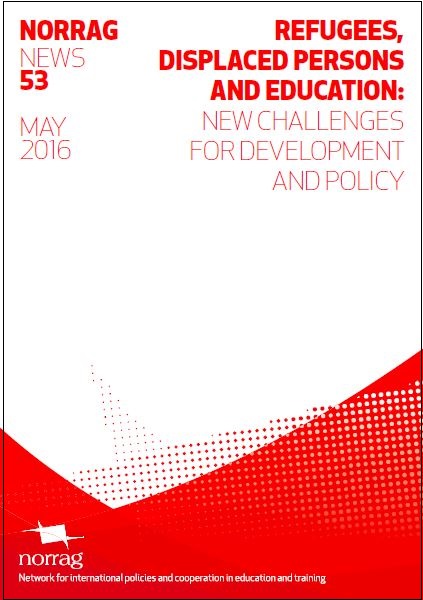Moving on? The Impact of Education for Refugees in First Asylum Countries By Sarah Dryden-Peterso
By Sarah Dryden-Peterson, Harvard Graduate School of Education
Four dimensions of refugees’ educational experiences are critical for teachers of refugees to understand: sporadic and limited schooling, language confusion, poor instruction, and school-based discrimination.
Educating large numbers of refugees is a new experience for most teachers. This is particularly true in Europe and North America, where prior to this year there have been very small numbers of refugees. What do teachers of refugees in these contexts need to know about their refugee students to help them succeed in school and become part of a new community?
Teachers need to know that 86 percent of refugees globally live in a country that neighbors the refugee’s conflict-affected country of origin. For example, the greatest numbers of Afghan refugees live in Pakistan; Congolese in Uganda; Somalis in Kenya, and Syrians in Turkey, Jordan and Lebanon. Countries hosting the greatest number of refugees globally now integrate refugees into their national education systems: refugees and citizens following the same curriculum; in the same language; sometimes, but not always, in the same classrooms. At the same time, these countries usually have already under-resourced and over-stretched education systems.
Yet, these countries also have the most experience in meeting the educational needs of large numbers of refugees. My research over the past decade in these settings of first asylum highlights four dimensions of refugees’ educational experiences that are critical for teachers of refugees to understand: sporadic and limited schooling, language confusion, poor instruction, and school-based discrimination
Sporadic and limited schooling. Only half of refugee children globally access primary education, which compares to 93 percent of all children. At secondary level, access rates are even lower, at 25 percent. These access rates do not usually represent children who have never been in school. For refugees, access is often sporadic, with missed years of schooling due to acute conflict in countries of origin or legal restrictions in sites of exile. As a result, refugee children are often behind their age-appropriate grade level.
Language confusion. By definition, refugees flee across international borders. This movement exposes refugee children to new education systems, often with a new language of instruction. Refugee children, and even adolescents, are often made to repeat early primary classes because “that is where language learning happens,” despite the disconnect between students’ language abilities and cognitive capacities. Further, there can be shifts in language policy, guided by politics between nation-states and assumptions about long-term exile or imminent return to the country of origin. Even for refugee children who remain in one place, these shifts result in language confusion and difficulty mastering academic content.
Poor instruction. Teachers of refugee students often have little subject matter or pedagogical training, with many lacking even the 10 days of training that would classify them as ‘trained,’ according to international definitions for refugees. In addition, class sizes often reach well over 100. Teachers of refugees describe feeling ill-equipped to meet the academic, social, and emotional needs of their refugee students. In this context, student participation is rare, and children are not expected to work in groups, ask questions, and engage in exploration. In settings where these are expectations for students, refugee children often struggle to adapt.
School-based discrimination. In their countries of origin and of first asylum, refugee children often experience curriculum that is highly politicized and discriminatory and have experiences in school that make them feel that they do not belong. Instead of being spaces of possibility, schools can become markers of present precarity and dead-end futures. Teachers of refugees have the enormous task of building relationships with refugee children and families that restore trust in schools.
Refugee children’s educational experiences often involve sporadic and limited schooling, language confusion, poor instruction, and school-based discrimination. Teachers’ understanding of these previous experiences can help refugee children, no matter where they find exile, to succeed academically and to become part of their new communities.
By Sarah Dryden-Peterson, Harvard Graduate School of Education.
Email: sarah_dryden-peterson@gse.harvard.edu
This blog is based on an article that appeared in NORRAG NEWS 53.
>> View the full list of articles in NN53 on ‘Refugees, Displaced Persons and Education: New Challenges for Development and Policy’
>> View all NORRAG Blogs on refugees/migration, ODA and Agenda 2030
Suggestions for further reading
Dryden-Peterson, S. (2015). Refugee education in countries of first asylum: Breaking open the black box of pre-resettlement experiences. Theory and Research in Education, 1-18.
Dryden-Peterson, S. and Adelman, E. (February 2016). Inside Syrian Refugee Schools Blog Series. www.brookings.edu/blogs/education-plus-development
- Inside Syrian Refugee Schools: In refugee schools, teachers struggle to create good conditions for learning.
- Inside Syrian Refugee Schools: Making room for refugees in second shifts.
- Inside Syrian Refugee Schools: In their search for a destination, teachers face difficult choices.
NORRAG (Network for International Policies and Cooperation in Education and Training) is an internationally recognised, multi-stakeholder network which has been seeking to inform, challenge and influence international education and training policies and cooperation for almost 30 years. NORRAG has more than 4,500 registered members worldwide and is free to join. Not a member? Join free here.

